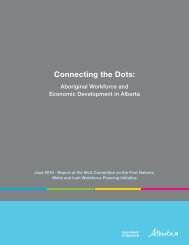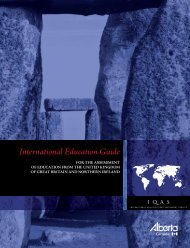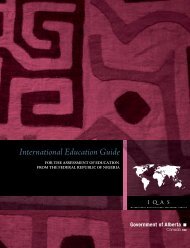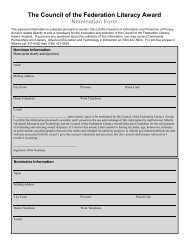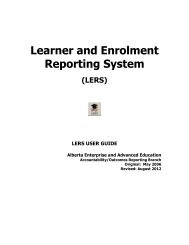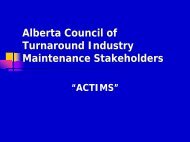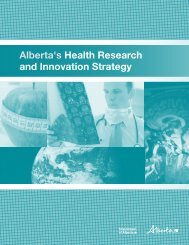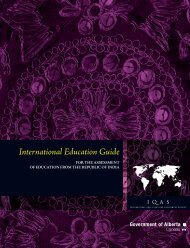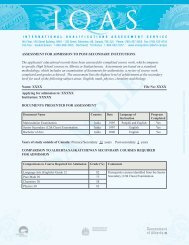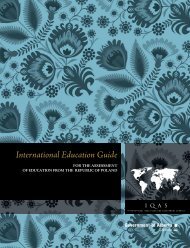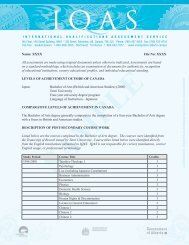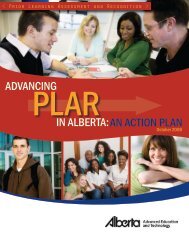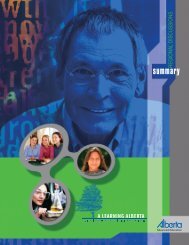International Education Guide - Enterprise and Advanced Education ...
International Education Guide - Enterprise and Advanced Education ...
International Education Guide - Enterprise and Advanced Education ...
Create successful ePaper yourself
Turn your PDF publications into a flip-book with our unique Google optimized e-Paper software.
.32<br />
INTERNATIONAL EDUCATION GUIDE for the assessment of education from the Islamic Republic of Pakistan<br />
Table 20.<br />
Fall Semester 2007<br />
Academic Calendar 2007–08, Bahauddin<br />
Zakariya University, Multan (Public)<br />
Semester begins 15 Aug 2007<br />
Mid-term exams 15–20 Oct 2007<br />
Final exams 17–22 Dec 2007<br />
Results 31 Dec 2007<br />
Spring Semester 2008<br />
Semester begins 17 Jan 2008<br />
Mid-term exams 3–8 Mar 2008<br />
Final exams 5–10 May 2008<br />
Results 19 May 2008<br />
Summer Semester 2008<br />
Semester begins 2 Jun 2008<br />
Mid-term exams 30 Jun 2008<br />
Final exams 4 Aug 2008<br />
Results 11 Aug 2008<br />
Table 21.<br />
Academic Calendar 2006–07, Sindh<br />
Agriculture University (Public)<br />
First Semester (Spring)<br />
Admission test 19 Nov 2006<br />
Class begins 1 Jan 2007<br />
Examinations 2–31 May 2007<br />
Results 17 Jun 2007<br />
Second Semester (Fall)<br />
Class begins 2 Jul 2007<br />
Examinations 29 Oct – 3 Nov 2007<br />
Results 16 Dec 2007<br />
Program length has traditionally been defined by years<br />
of full-time study, for example, two-year bachelor’s (pass)<br />
degrees <strong>and</strong> three-year bachelor’s (honours) degrees. This<br />
is being replaced by the credit system, with program length<br />
defined in terms of minimum credits or credit hours. One<br />
credit or credit hour generally represents one instructional<br />
hour per week over the course of an 18-week semester (with<br />
14 to 15 weeks of instruction). For example, a four-year<br />
bachelor’s degree may require between 120 <strong>and</strong> 140 credits<br />
of coursework.<br />
Language of Instruction<br />
English has been the language of instruction for higher<br />
education since the British colonial period. After Pakistan<br />
gained independence in 1947, Urdu was made the national<br />
language. Several national education documents envisaged<br />
the eventual replacement of English by Urdu as the language<br />
of advanced study <strong>and</strong> research, but this has not happened.<br />
Today both Urdu <strong>and</strong> English are languages of instruction<br />
in higher education. While English is the dominant<br />
language in science <strong>and</strong> technical programs, Urdu remains<br />
a common language of instruction in most other subjects,<br />
partly due to the lack of English competence on the part<br />
of faculty <strong>and</strong> students <strong>and</strong> to the lack of English language<br />
learning resources.<br />
Grading Scale<br />
Percentage marks are commonly used. The Pakistani system<br />
is low marking, with 40 per cent as a common minimum<br />
pass mark, although some institutions or programs have<br />
a 50 per cent pass. Grading scale information is usually<br />
provided on the marks sheets issued by universities.<br />
Table 22.<br />
Table 23.<br />
Grading Scale, Allama Iqbal Open<br />
University (National)<br />
Percentage (%) Mark<br />
Letter<br />
Grade<br />
Letter Grade<br />
80 <strong>and</strong> above A+<br />
70–79 A<br />
60–69 B<br />
50–59 C<br />
40–49 D<br />
Below 40<br />
Fail<br />
Grading Scale, University of Agriculture,<br />
Faisalabad (Public)<br />
Grade<br />
Point<br />
Percentage (%)<br />
Mark<br />
Descriptor<br />
A 4 80–100 Excellent<br />
B 3 65–79 Good<br />
C 2 50–64 Satisfactory<br />
D 1 40–49 Pass<br />
F 0 Below 40 Fail




